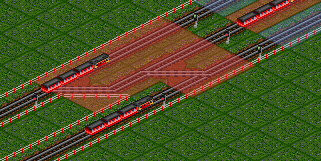

Just as with block signals, one-way path signals cant be passed from behind. Programmable signals can be used to combine the useful features of presignals and the advantages of path signals - path signals override the pre-signal behaviour by default. Standard path signal (can be passed in the reverse direction, and is ignored in that case) and. Both path signals can be built heading one direction (A or B). This could be done by waypoints of course, but sometimes there is no room for them.

Routing restrictions are very helpful to control train movement when they should only use certain tracks. Path signals give you less control over trains paths (since the trains choose them) and are slower to react so will be more likely to cause queueing with dense incoming traffic.

These rules work in addition to the standard behaviour of the underlying signal type, which means you cannot create a signal that permits passing into a block thats occupied by another train.īecause of the huge complexity and the amount of possible settings tehre is an extra page with detailed explanations. Note that it then reserves a path through the station. Deleting the path outside the middle station (eg the tile pointed to by the arrow) causes the train to find a path and continue on its way.
#Openttd path signals free
The player creates a rule or a set of rules which determine when the signal should show "Stop!". The train is indefinitely waiting for a free path, even though there already is one (actually, more than one).

Programmable signals allow almost complete control over signal behaviour. This can be used to route a train with a certain freight or speed onto a specific track. The 1-way signal has a small horizontal bar below the lights. If some tracks are not available because already booked for another opened route, the route cannot be opened. Aaron Kurtzhals at 20:40 AaronKurtzhals It's a 'regular' path signal. Railway control operators open 'routes' that book a path from an origin to a destination, opening all signals and setting points in the right direction along the way. In other words, the restriction discourages the train to go to the signal if it does not meet the restriction criteria. A 1-way path signal in the spot shown in your screenshot would prevent the train from going to the depot. The route finder does not search for a way past a restricted signal if the train does not meet the restriction criterion. It influences train pathfinding by setting user-defined restrictions upon signals. I might not of explained it very well but basically the image is just an example but is correct if you wanted trains to use that depot and not ignore it.Įdit: The depot at the end of the blue line's station is redundant i just made this example on auto pilot and didn't even realize because i was half asleep only just noticed it now.Routing destrictions are a very powerful and rather complex feature that can be used to control train movement in a manner not possible before. The train therefore won't see it and it will never use that depot. If this happens you need to adjust your junction that goes to the depot to start before the closet path signal and just put a path signal after the junction on both lines.Įxample the blue line is in this case hosting the junction if i were to instead put the path signal before the split then it would not be on the blue line that is leading to the depot anymore and therefore it would be different color after the split. As of OpenTTD 12.0, only Path-Based Signals (PBS) and Block Signals are enabled by default in order to make it easier for new players to get started and learn. Like raptor mentioned if it is inside a section of track that is defined by two path signals it can sometimes get confused and never knows about the line going to the depot Path Signal This signal will be called a Path Signal. If you are having trouble getting it into that specific depot you made and there is a direct line to it, it might be to do with your signals blocking the junction. Originally posted by Jbk07:I have breakdowns turned on, so I think it's a pathfinding issue because when I click the "send to depot" button it says that the train cannot find a path to the depot even though there is a path to it that it can reach


 0 kommentar(er)
0 kommentar(er)
